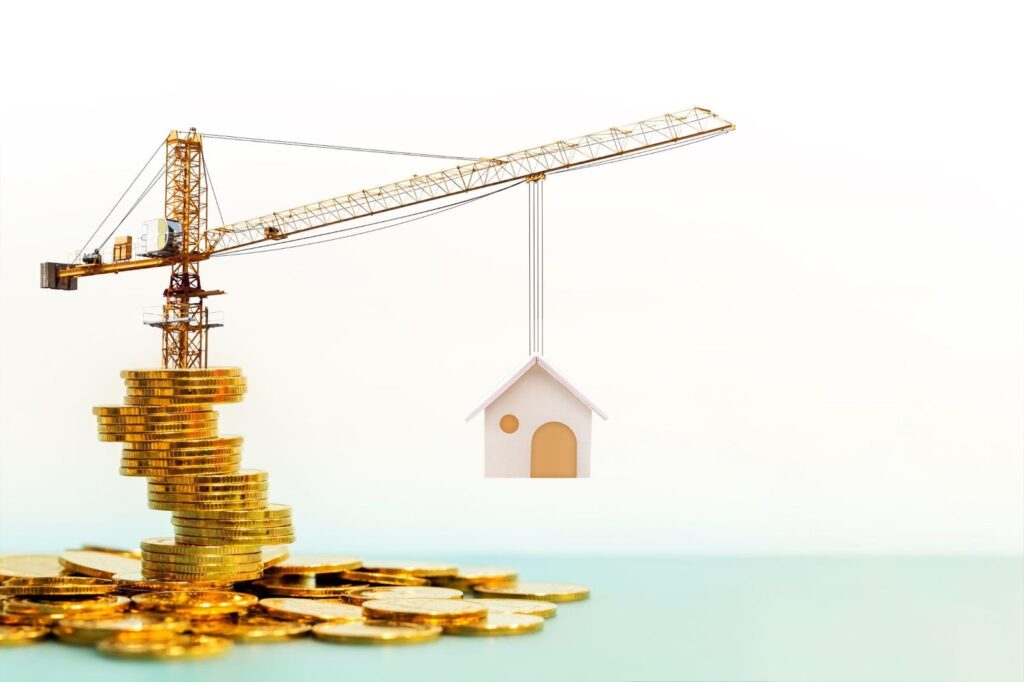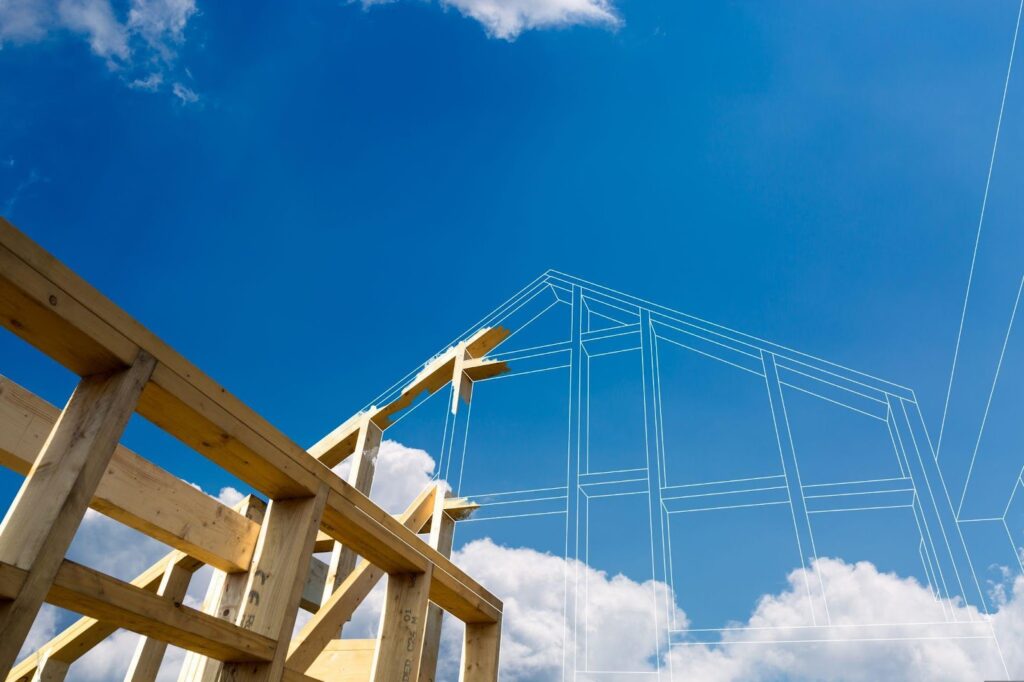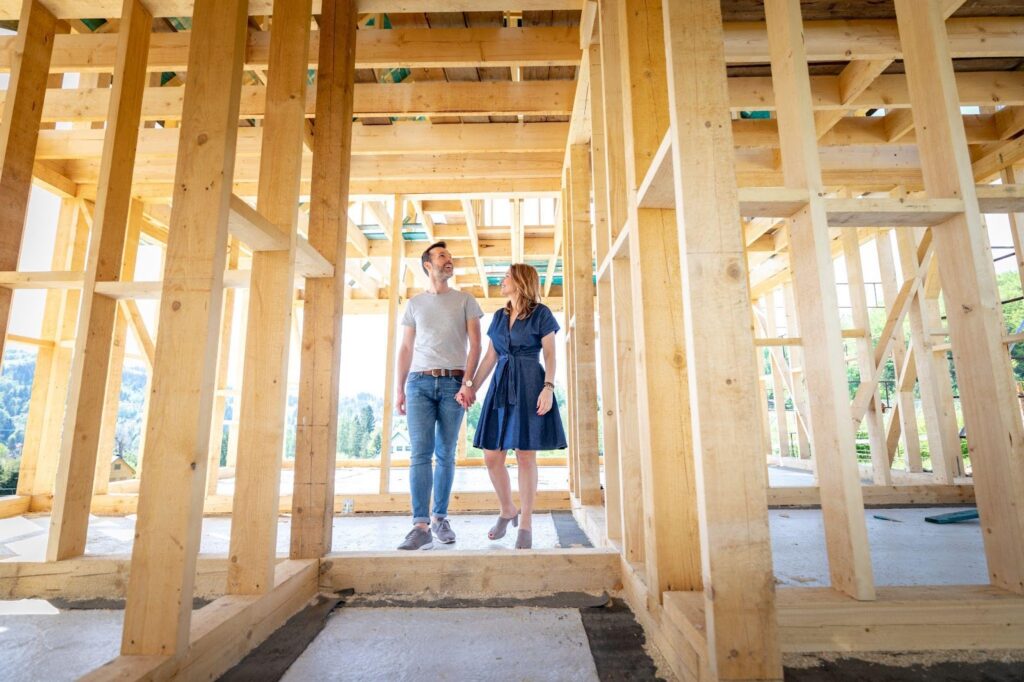Building your dream home from the ground up is an exhilarating journey that brings your visions to life. However, the path from blueprint to bricks is strewn with financial and logistical challenges. The thrill of selecting every detail tailored to your preference comes with the weighty task of ensuring you can fund the project without hiccups.
Understanding the various financing options and strategies is crucial in navigating this complex process. Whether you opt for a construction-to-permanent loan that smoothly transitions into a mortgage or a standalone construction loan that suits your financial circumstances, each choice plays a pivotal role in the overall success of your project.
There is more to financing than securing the funds to start building; it also includes sustaining the flow of finances in a way that aligns with construction timelines and unforeseen costs.
This blog aims to demystify the intricacies of financing your new home construction. By diving deep into the types of loans, budgeting techniques, and financial preparation, we’ll equip you with the knowledge to make informed decisions. Proper financial planning ensures your build goes as planned and safeguards against common pitfalls that turn your dream build into a financial strain.
Join us as we explore how to transform your dream home from a vivid imagination into a tangible reality, focusing on financial preparedness as the foundation of a smooth construction experience.
Construction loans
Understanding construction loans is essential for anyone looking to finance the building of a custom home. These loans are distinct from traditional home mortgages, typically used to purchase existing properties.
Construction loans are designed specifically to fund the various stages of a home’s construction and often follow a unique disbursement schedule that matches the project’s milestones.
Unlike standard mortgages, construction loans usually feature shorter terms and higher interest rates because they are considered riskier by lenders. The funds are released in increments or “draws” as construction reaches certain phases, often contingent upon successful inspections to ensure each stage meets the required standards.
There are two primary types of construction loans: construction-to-permanent and standalone construction loans.
Construction-to-permanent loans provide a convenient two-in-one financing solution that transitions from funding construction to becoming a traditional mortgage upon the project’s completion, reducing the complexity and cost associated with multiple closings.
Standalone construction loans require full repayment or refinancing into a permanent mortgage after the build is complete, offering flexibility but potentially higher costs due to double closing processes.
Choosing the right construction loan depends on your financial stability and future expectations. By understanding how these loans function and their impact on your project, you’ll make informed decisions that align with your financial goals and help bring your dream home to life.

Preparing for loan approval
Securing approval for a construction loan is crucial for financing your new home construction. To ensure a smooth process, familiarize yourself with the prerequisites and adequately prepare to meet or surpass lender expectations.
Credit score
A strong credit score, typically 680 or above, is essential as it influences your interest rates and loan terms, reflecting your creditworthiness and financial reliability.
Down payment
Expect to make a down payment of at least 20% to 25% of the total construction costs, which confirms your commitment and reduces the lender’s risk.
Documentation
Lenders will require detailed construction plans, budgets, timelines, and a contract with a licensed builder. They also need proof of your builder’s credentials to ensure they have the financial stability to complete the project.
Tips to Enhance Your Financial Standing
- Boost your credit ccore: Check your credit report for errors, pay down debts, and avoid new credit obligations.
- Increase savings: More savings will help cover the down payment, demonstrate financial stability, and prepare you for unforeseen costs.
- Stabilize employment: Ensure you have a steady job and reliable income, as lenders will likely verify your employment history.
- Select a reputable builder: Choose a builder with a strong track record and provide your lender with documentation proving your builder’s qualifications.
By carefully preparing and understanding the lender’s requirements, you improve your chances of securing a construction loan, setting a solid financial foundation for your home build. This proactive approach helps transform your construction dream into reality.
Navigating the application process
Navigating the construction loan application process involves a series of important steps and thorough documentation to ensure everything runs smoothly. Here’s how to manage it effectively:
Step 1: Gather documentation
Start your application by assembling all necessary documents. You’ll need proof of income, like recent pay stubs or tax returns, proof of employment, and your credit report to demonstrate financial stability. Include detailed construction plans, such as blueprints and budgets, and provide your builder’s credentials and the property details to assure lenders of the project’s viability.
Step 2: Choose the right lender
Research lenders experienced in construction loans, comparing their terms and rates. Local banks and credit unions often offer flexible options for local projects.
Step 3: Submit your application
After selecting a lender and compiling your documents, submit your loan application. Be ready to provide additional information and respond to any queries from the loan officer.
Step 4: Loan underwriting
The lender will assess the risk associated with your loan during the underwriting process, potentially involving property and construction plan appraisals.
Step 5: Approval and loan closing
Upon loan approval, you’ll close the loan, finalize terms, and handle necessary payments. Funds will then be released in stages aligned with your construction milestones.
Step 6: Managing disbursements
Coordinate with your builder and lender to manage fund disbursements. Lenders will perform inspections to confirm each phase of construction is completed before releasing further funds.
By being organized, attentive, and proactive in gathering and submitting required documentation, you streamline your construction loan application, keeping your home-building project on track and within budget.

Budgeting for your home construction
Creating a realistic budget is crucial for the success of your home construction project. Start by categorizing the total costs, including land, permits, builder and architect fees, materials, labor, and interior finishes. Work with your builder and architect to get accurate estimates based on current market rates and specific project details.
Break down and research costs
When budgeting for your home construction, it’s essential to meticulously document every expense, from the initial groundbreaking to the final touches, such as landscaping and painting. Ensuring you capture each cost helps maintain a clear financial picture throughout the project.
Obtain multiple quotes for both materials and labor. Comparing these can lead to significant savings. Additionally, don’t overlook the costs associated with connecting utilities. If services like water, electricity, and gas aren’t already established on your property, these will need to be factored into your overall budget to avoid surprises later in the construction process.
Monitor and manage your budget
Keep a close eye on spending with regular budget reviews and updates using spreadsheets or software. Maintain open communication with your construction team to ensure everyone is aligned with budget constraints and project goals.
Set aside 10% to 15% of your budget for unexpected costs. This fund provides flexibility and ensures financial hitches do not derail your project.
By diligently planning and maintaining oversight of your budget, including a contingency for unexpected expenses, you ensure a smooth construction process and a successful completion of your home.
Choosing the right lender
Selecting the right lender is crucial when financing your home construction, as it affects everything from loan terms to the ease of the building process. Here’s how to choose a lender with expertise in construction loans:
Evaluate lender expertise
Look for lenders specializing in construction loans who understand the home-building process. They should offer flexible terms tailored to construction needs, such as milestone-based disbursements and interest-only payments.
Inquire about their experience with construction loans and ask for examples of previously financed projects. Make sure the lender clearly explains the loan process and requirements at each stage.
Compare rates and terms
Don’t choose the first lender you find. Compare rates, fees, and terms from several lenders. Pay attention to loan duration, draw schedules, and penalties for insights into the overall cost.
Check online reviews and testimonials to gauge the lender’s reliability and service quality. Speak with previous clients who have completed similar projects to understand their experience with the lender.
Choose a lender known for good communication and responsiveness. Ensure the lender’s disbursement schedule suits your project timeline and cash flow needs.
By thoroughly researching and comparing potential lenders, you will find one that meets your financial needs and supports the successful completion of your home. This ensures a partnership with a well-versed lender in construction financing and is committed to a smooth building process.
Managing construction loan disbursements
Managing the disbursement of construction loan funds is crucial for the smooth execution of your home-building project. Funds are typically not released in a lump sum but disbursed incrementally as specific project milestones are achieved, ensuring efficient use of funds and adherence to the project plan.
Disbursement process
- Initial disbursement: This may cover land purchase or the initial contractor payment to commence work.
- Scheduled draws: Funds are released in phases aligned with key construction stages — like foundation laying, framing, and interior finishing — pending lender approval and successful completion of each stage.
- Final draw: Issued upon project completion, covering final touches and outstanding contractor payments.
Role of inspections and appraisals
Inspections are conducted after each construction phase to ensure that all work meets the required standards; this is crucial for the release of subsequent funding.
Additionally, appraisals are performed initially and periodically throughout the project to assess the value of the work completed. These appraisals are adjusted based on any modifications to the plans or changes in the market, ensuring that the project’s financing remains aligned with its current value.
Together, these steps guarantee that the construction progresses on a financially and structurally sound basis.
Tips for managing the draw schedule
- Maintain a timeline: Regularly compare progress against the project timeline.
- Prepare for inspections: Coordinate with your builder to ready the site for timely inspections.
- Communicate changes: Inform your lender of any adjustments to ensure they align with funding requirements.
By proactively coordinating with your builder and lender and understanding the importance of inspections and appraisals, you maintain financial control and structural integrity throughout your construction project, ensuring successful completion.
Transitioning from construction loan to mortgage
Transitioning from a construction loan to a permanent mortgage is a pivotal financial step in completing your new home. This process, known as “loan conversion,” replaces the short-term, higher-interest construction loan with a traditional long-term mortgage.
Loan conversion process
Completion of construction
Once your home is fully built and all agreements with the builder are met, the construction loan matures. All inspections and appraisals must confirm that construction meets specified standards.
Final appraisal
This appraisal confirms the home’s market value, assuring the lender of the investment’s worth and determining the mortgage amount.
Loan conversion application
Applying for this conversion resembles the initial loan application process involving credit checks and financial assessments.
Settlement of terms
You finalize the mortgage terms, including the interest rate and repayment schedule.
Financial benefits and considerations
Transitioning from a construction loan to a permanent mortgage offers several financial advantages, including lower interest rates that reduce long-term costs and extended repayment periods that make monthly payments more manageable.
However, potential challenges, such as financing additional expenses from construction overruns, affect the loan amount and terms. There is also a risk of increased mortgage rates if transitioning from a fixed to an adjustable rate or due to significant market rate changes.
Additionally, moving to a mortgage may incur closing costs, which need to be factored into your overall financial planning.

Government programs and assistance
Navigating the financial landscape of home construction is often daunting, but numerous government programs and assistance options are available to ease the burden. These programs reduce upfront costs and provide favorable loan terms, making the dream of building a custom home more achievable.
Federal programs for home construction
FHA construction-to-permanent loan
This program by the Federal Housing Administration finances the construction of a home and its conversion to a permanent mortgage with a single loan closing, simplifying the process and saving on costs.
VA construction loans
Available for veterans and service members, these loans offered by the U.S. Department of Veterans Affairs require no down payment or minimum credit score, lowering barriers for building new homes.
Energy-efficient construction credits
These are available federal tax credits for homes meeting specific energy-efficiency standards that help offset costs associated with installing sustainable systems like solar panels or geothermal heat pumps.
State and local assistance programs
State housing finance agencies (HFAs)
HFAs offer loans with lower interest rates and features like down payment assistance, which is particularly beneficial for qualifying individuals.
Local grants and subsidies
Many local governments provide financial aid to cover construction costs or offer reduced-rate financing, often targeted at first-time homebuyers or low-income families.
Tax Incentives and Credits:
To maximize these opportunities, thoroughly research available programs through local housing authorities or official websites, assess eligibility carefully and consider long-term implications such as potential tax increases or effects on home resale value.
Leveraging these government programs and assistance lessens the financial challenges of building a new home, facilitating the construction process and enhancing long-term financial stability and sustainability in your new home.
Common pitfalls in financing home construction
Financing home construction presents its own challenges, but being aware of common financial pitfalls and how to avoid them will keep your project on budget and on schedule.
- Underestimating costs: Often, due to poor planning, this leads to unexpected expenses.
- Inadequate contingency Fund: Failing to allocate enough for unforeseen issues causes budget overruns.
- Over-extending financially: Opting for luxury finishes or unplanned upgrades quickly depletes funds.
- Misunderstanding loan terms: Not fully grasping your loan’s details, like interest rates and draw schedules, can lead to financial stress.
- Delayed decision making: Procrastination in decision-making slows the project and increases costs.

Patterson Homes makes new home construction easy!
The right knowledge and preparation can significantly streamline the entire new home construction process, making your dream home a reality with fewer financial hurdles. Choosing a knowledgeable and reliable partner is key in this journey, and Patterson Homes is the best choice for you and your future.
With our extensive experience in managing complex construction projects and a deep understanding of the intricacies of home financing, Patterson Homes will guide you through every phase of your project. From securing the right construction loan to managing budgets and avoiding common financial pitfalls, our expertise ensures that your build is beautiful but also financially sound.
Reach out to Patterson Homes or call our office at 801-796-2932 today to start your journey toward creating a home tailored perfectly to your vision and budget. Your dream home awaits, and Patterson Homes is here to help you every step of the way.

